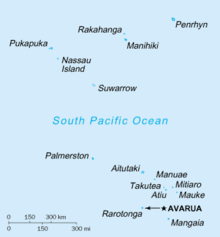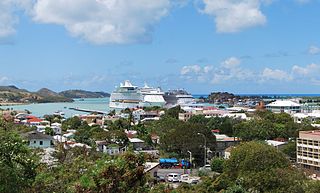
The Cook Islands is a self-governing island country in the South Pacific Ocean in free association with New Zealand. It comprises 15 islands whose total land area is 236.7 square kilometres (91 sq mi). The Cook Islands' Exclusive Economic Zone (EEZ) covers 1,960,027 square kilometres (756,771 sq mi) of ocean.
This article lists transport in the Cook Islands.

Aitutaki, also traditionally known as Araʻura and Utataki, is the second most-populated island in the Cook Islands, after Rarotonga. It is an "almost atoll", with fifteen islets in a lagoon adjacent to the main island. Total land area is 18.05 km2 (6.97 sq mi), and the lagoon has an area of between 50 and 74 km2. A major tourist destination, Aitutaki is the second most visited island of the Cook Islands.

Rarotonga is the largest and most populous of the Cook Islands. The island is volcanic, with an area of 67.39 km2 (26.02 sq mi), and is home to almost 75% of the country's population, with 10,898 of a total population of 15,040. The Cook Islands' Parliament buildings and international airport are on Rarotonga. Rarotonga is a very popular tourist destination with many resorts, hotels and motels. The chief town, Avarua, on the north coast, is the capital of the Cook Islands.

Avarua is a town and district in the north of the island of Rarotonga, and is the national capital of the Cook Islands.
MyTravel Airways Limited was a British scheduled and charter airline with headquarters in Manchester, England. It operated worldwide holiday charter services mainly for its parent company, the MyTravel Group. The airline merged with Thomas Cook Airlines UK Limited in 2008 and was renamed Thomas Cook Airlines Limited.
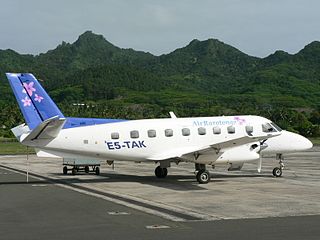
Air Rarotonga is an airline based in Rarotonga, Cook Islands and is ‘The Airline of the Cook Islands’. It operates inter-island and regional scheduled services throughout the Cook Islands and to Tahiti. It also operates chartered flights to French Polynesia, Niue, Samoa, Kiribati and Tonga. Its main base and hub is Rarotonga International Airport.
Air Tahiti is a French airline company which operates in French Polynesia. Its main hub is Faa'a International Airport. It is the largest private employer in French Polynesia.

Rarotonga International Airport is the Cook Islands' main international gateway, located in the town and district of Avarua, Rarotonga, 3 km (1.9 mi) west of the downtown area on the northern coast. Originally built in 1944, the airport was expanded in the early 1970s, and officially opened for jets in January 1974.

Dunedin Airport, officially Dunedin International Airport, also known as Momona Airport, is an international airport in the Otago region of the South Island of New Zealand, serving Dunedin city and the Otago and Southland regions. Dunedin Airport is one of two international airports in Otago, the other being Queenstown International Airport. It is located adjacent to the village of Momona on the Taieri Plains approximately 22 kilometres south west of Dunedin CBD. It is the fifth busiest airport in New Zealand by passengers.
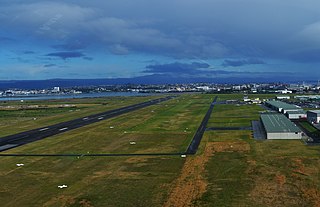
Tauranga Airport is an airport serving the city of Tauranga, New Zealand. It is located adjacent to Tauranga Harbour in the suburb of Mount Maunganui, approximately 3 km northeast of Tauranga CBD. The terminal is located to the north of the runway, on Jean Batten Drive, and consists of a two-storey building with four tarmac gates. Air New Zealand serves the airport through its subsidiaries Mount Cook Airline and Air Nelson, with flights to Auckland, Wellington and Christchurch. A further two regional airlines also operate to the airport, as well as scenic and charter flights, skydiving operations and general aviation.
The Fiji Meteorological Service (FMS) is a Department of the government of Fiji responsible for providing weather forecasts and is based on the grounds of Nadi Airport in Nadi. The current director of Fiji Meteorological Service is Misaeli Funaki. Since 1985, FMS has been responsible for naming and tracking tropical cyclones in the Southwest Pacific region. Current Meteorologists working at FMS have a Graduate Diploma in Meteorology from the Australian Bureau of Meteorology.

Aitutaki Airport is the airport for Aitutaki, one of the Cook Islands. The airport was originally constructed by the United States and New Zealand militaries during World War II. The runway was upgraded in 2004.
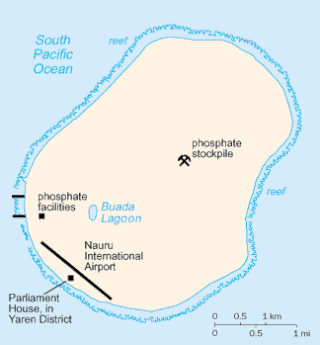
Nauru is a small, isolated western Pacific island, which lacks many of the tourist facilities of some of its larger neighbours, such as Fiji, the Cook Islands, or even New Caledonia. Tourism is not a major contributor to the economy, with only around 200 tourists a year visiting the island.
The Convention for the Suppression of Unlawful Acts against the Safety of Civil Aviation is a multilateral treaty by which states agree to prohibit and punish behaviour which may threaten the safety of civil aviation.

Renewable energy in the Cook Islands is primarily provided by solar energy and biomass. Since 2011 the Cook Islands has embarked on a programme of renewable energy development to improve its energy security and reduce greenhouse gas emissions, with an initial goal of reaching 50% renewable electricity by 2015, and 100% by 2020. The programme has been assisted by the governments of Japan, Australia, and New Zealand, and the Asian Development Bank.
